Compose your addresses according to the best practices for a fast and correct processing of your mail
Help us to serve you better
The right mail in the right letterbox? You just have to apply a few very simple rules when drawing up your addresses. There are many advantages:
Optimal sorting and delivery of mail, less risk of errors or late delivery, lower logistical costs due to non-deliverable mail, better managed communication budgets... and satisfied senders and recipients all round!
1. Scope
2. A correctly written address
3. Address position
4. Address structure
5. Address format
6. Sender's address
7. Abbreviations
8. Mail addressed to a box
9. Private house numbers
10. Sealing envelopes
11. Mail wrapped in plastic film
1. Scope
Our recommendations apply to both mail items you send and mail items you receive.
With that in mind, please ensure that your full address details are stated on all communication material: writing paper, invoices, purchase orders, advertising, envelopes, business cards, directory registration, email signature...
In doing so, mail for you will also be correctly addressed.
2. A correctly written address
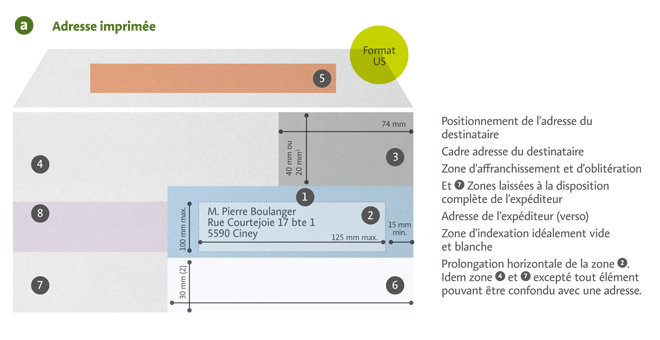
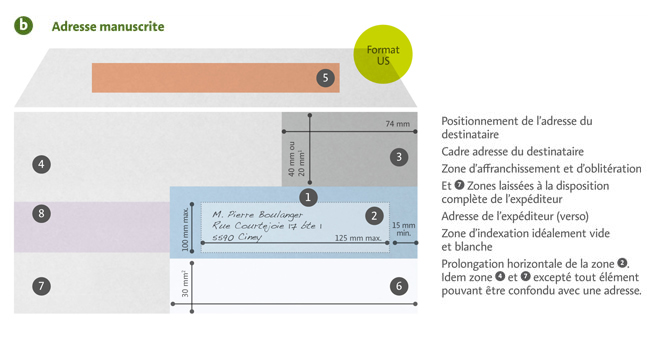
3. Address position
- The address must be confined to the address zone, which is up to 125mm wide and up to 100mm high (ideally it should be 40mm high).
- There should be an empty space of at least 30mm below the address zone. (30mm from the bottom line or, when using window envelopes, 30mm from the bottom of the window).
- A space of at least 15mm to the right of the address zone should remain empty.
- The address zone must not contain any other information than the address.
- When using a window envelope, take care that the whole address is visible through the window.
- Any text that could be confused with the addressee's address must not be visible through the window (such as the sender's address, an internal code that could be mistaken for a postcode or a VAT number).
4. Address structure

| ELEMENTS | EXAMPLES | COMPULSORY |
| Name | Pierre Boulanger |  |
| Position | Département Qualité |  If applicable If applicable |
| Organisation | bpost |  If applicable If applicable |
| Building, floor... | Bâtiment central étage 2 |  If applicable If applicable |
| Street, house number, box number | Rue Courtejoie 17 bte 1 |  |
| Postcode and name of municipality | 5590 Ciney |  |
| Country name in the event of mail to a foreign address (e.g. France) . The country name should not be included on mail to Belgian addresses |
 For foreign addresses only For foreign addresses only |
| ELEMENTS | DESCRIPTIONS |
|
Street type Street name Number Box |
|
| Postcode Municipality |
|
| Foreign countries |
|
5. Address format
A. Printed address (preferred)
Printed addresses are easier to recognise, sort and deliver.
Contrast
Black on a white background is preferable.
- Use Arial, Helvetica or Verdana wherever possible.
- The following are not recommended:
> Fonts that imitate handwriting;
> Fonts with characters that overlap or are printed close together (such as Arial Narrow);
> Serified fonts (fonts with characters that end in strokes that are slightly projected, such as Times New Roman);
> Bold and or underlined fonts;
> Inverted fonts;
> Italicised fonts (more than 5 degrees).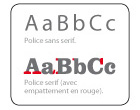
- The ideal font size is 11 or 12 points.

- A space must be placed between every word and between words and numerals.
- Avoid the use of multiple spaces or a long tabulation as a separation device.
- Use sufficient line spacing to ensure the letters do not overlap.
- There should be no blank lines between address lines.

Alignment
- All address lines must be aligned to the left.
Sloping
- The address must be parallel to the side of the long edge of the envelope as much as possible with a maximum slope of 10°.

Punctuation and special characters
- Punctuation must be avoided.
- Avoid special characters,such as /, #, &, §, ", " ( or ).
Digits
- Dates and cardinal numbers must be in Arabic numerals (e.g. Rue du 11 novembre, rue des 4 saisons).
- Exceptions: Names of monarchs and popes. The names of monarchs and popes generally comprise a first name followed by an ordinal number, written in Roman numerals (e.g.: Rue du Roi Albert II or Rue du Pape Benoît XVI).
B. Handwritten address
Handwriting
- Write as legibly as possible.
- Do not join together the digits of the postcode and ensure they are clearly separated.
- Write the name of the municipality in capital letters.
Spaces
- A space must be placed between every word and between words and numerals.
- Do not make these spaces too large.
- Use sufficient line spacing to ensure the letters do not overlap.
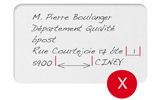
Alignment
- All address lines must be aligned to the left.
Sloping
- The address must be parallel to the side of the long edge of the envelope as much as possible with a maximum slope of 10°.
Punctuation and special characters
- Punctuation must be avoided.
- Avoid special characters, such as /, #, &, §, ", " ( or ).
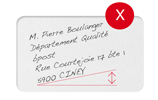
Digits
- Dates and cardinal numbers must be in Arabic numerals (e.g. Rue du 11 novembre, rue des 4 saisons).
- Exceptions: Names of monarchs and popes. The names of monarchs and popes generally comprise a first name followed by an ordinal number, written in Roman numerals (e.g.: Rue du Roi Albert II or Rue du Pape Benoît XVI).
6. Sender's address
- The sender's address should preferably be on the back of the envelope.
- If the sender's address cannot be placed on the back of the envelope, it should be in the upper left-hand corner in smaller characters than those used for the addressee's address.
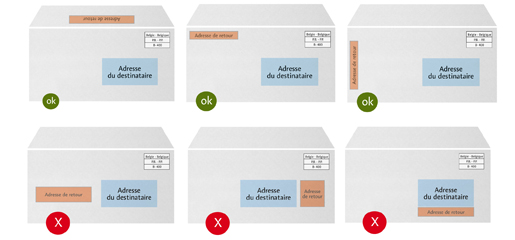
7. Abbreviations
- Do not abbreviate the name of the municipality.
- The street type must not be abbreviated:
> Only if absolutely necessary to avoid running out of space in the address zone; > Use the table below as a guide.
- The name of the street must only be abbreviated if absolutely necessary, and, if this is done, care should be taken to avoid confusion with similar street names in the same municipality.
8. Mail addressed to a box
| Mail to the named main tenant or secondary tenant (natural persons) |
e.g. Mr X Box 15 1000 Bruxelles De Brouckère |
| Mail to a box, without further specification |
e.g. Box 24 6000 Charleroi Ville Haute |
9. House numbers
| Multiple numbers Use '-' to separate the numbers. Do not separate numbers with a space or with / . |
Avenue Louise 43-45 |
| Numeric extensions to building numbers Not to be confused with a letterbox. This can be combined with a box number if necessary. |
Dieweg 61/2 (sans espace) Place Joseph Wauters 16/1 bte 8 |
| Alphabetical extensions to building numbers Not to be confused with a letterbox. This can be combined with a box number if necessary. |
Allée de la Meuse 1B (no punctuation or space) Avenue de Bouillon 16B bte 207 |
10. Sealing envelopes
- Envelopes must be sealed to ensure they do not come open during sorting.
The flap must be sealed on the back of the envelope.
Envelopes must not be closed with staples, paperclips or metallic eyelets, which could cause damage to our sorting equipment.
Envelopes must not stick together.
11. Mail wrapped in plastic film
- Ideally, the address should be printed on a white label affixed to the plastic film.
The address may also be printed on a white sheet placed inside the plastic film and covering at least 95% of the total surface of the mail item.
Any text that could be confused with the recipient's address must be avoided on the reverse side.
